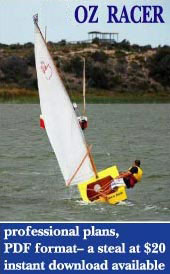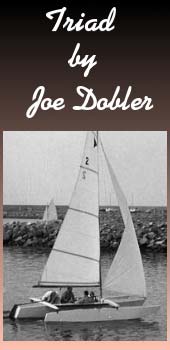Hidden Propulsion via Modified Application of the Leeboard, Mizzen, and Rudder
Part One - Part Two
Most of us, when we saw our first sailboat, were enamored with the silky ease and enigmatic glide of a sailboat slipping across the water. It wasn't long, before we realized that there was no motor, mounted on the back, which was responsible for the silent graceful propulsion of the voluminous sail breasted maiden of the waters.
A basic course in Sailing, will provide instruction on the Standard Sail Rigging, which is composed of four subsystems: Sails, Centerboard, Rudder, and the Hull. Each subsystem produces a unified dynamic product: Propulsion, Lateral Drift Control, Forward Direction Control, and the Location of the Center of Gravity (CG) along the Center Line of the Hull.
* The Sails, produce Propulsion
* The Centerboard, produces Lateral Drift Control
* The Rudder, produces Forward Direction Control
* The Hull, produces a CG along the Center Line
The Sails, are the only subsystem that produces Propulsion...
The Holy Grail of Sailboats: Find a way for the other Subsystems to Produce Propulsion.
The reality of such a thing, sounds like a pure Greek Mythology, as told by a Drunken Caribbean Pirate. However, via a Modified Application of the Standard Sail Rigging Configuration, Hidden Propulsion can be produced as a By Product of the following Foils: Leeboard, Mizzen Sail, and the Rudder.
* The Mizzen Sail will produce both: Stern Control Trim, and Propulsion as a By Product
* The Leeboard will produce both: Lateral Drift Control, and Propulsion as a By Product
* The Rudder will produce both: Forward Direction Control, and Propulsion as a By Product
Example: The winds are blowing at 10 mph, and the Sailboat is cruising along on beam reach. The Leeboard is generating a lateral force of 24 Lbs, the Mizzen Sail is generating a lateral force of 12 Lbs, and the Rudder is generating a lateral force of 6 Lbs. See Figure 3, for an illustration.
* Leeboard Lateral Force = 24 Lbs
* Mizzen Sail Lateral Force = 12 Lbs
* Rudder Lateral Force = 6 Lbs
 |
Fig. 3 |
Therefore, the maximum Propulsion Force By Product that could be produced:
* Leeboard = 24 Lbs * 50% = 12 Lbs of Propulsion
* Mizzen Sail = 12 Lbs * 50% = 6 Lbs of Propulsion
* Rudder = 6 Lbs * 50% = 3 Lbs of Propulsion
Total = 12 Lbs + 6 Lbs + 3 Lbs = 21 Lbs of Propulsion
The Principle, which Produces Propulsion as a By Product
Standard Sail Rigging is composed of both aerodynamic (Sails), and hydrodynamic (Centerboard, Rudder) Foils. Each Foil, is designed to produce a Force, which is applied to the CG along the Center Line of the Hull. Because, Standard Sail Rigging Configurations, employ the Foils along the Center Line of the Hull, each of the Foils will not produce a Propulsion Force By Product.
On the other hand, a Modified Application of a Standard Sail Rigging Configuration, employs the Foils at an offset from the Center Line of the Hull. The Foils are employed on both sides of the Hull. Therefore, each of the offset Foils, will produce a Propulsion Force By Product.
The Foils which can be employed at an offset from the Center Line of the Hull, are the Leeboard, the Mizzen Sail, and the Rudder. Each of these Foils, when correctly deployed at offset from the Center Line along the Hull, will produce a Propulsion Force By Product. Each of these Foils, when incorrectly deployed at an offset from the Center Line along the Hull, will produce a Drag Force By Product.
How Much Propulsion Force By Product can a Foil Produce
A Foil will produce a Propulsion Force By Product, by up to 50% of the Lateral Force produced by the Foil. For example: assume a Leeboard is producing a Lateral Force of 50 Lbs; the Leeboard will also produce a Propulsion Force By Product up to 25 Lbs.
Can I set up the Sailboat to Maximize the Net Total Propulsion (By Product)
Yes; of the three Foils, the Leeboard can produce the most Propulsion Force By Product, followed by the Mizzen, and then the Rudder. The performance for each of the three foils, depend on the physical location of the CG along the Center Line of the Hull. Therefore, to produce maximum Propulsion, adjust the location the CG along the Center Line of Hull.
Modified Application of the Leeboard, Which Produces a Propulsion Force By Product
The Standard Sail Rigging employs a Leeboard on an asymmetrical basis; the Leeboard is employed on only one side of the sailboat. The Leeboard, by default, is employed at an offset from the Center Line of the Hull. Therefore, an asymmetrical Leeboard configuration will always produce either a Drag Force By Product, or a Propulsion Force By Product.
A Modified Application of the Leeboard employs a Leeboard on both sides of the Sailboat, however, only one Leeboard is deployed at a time. The Leeboard on the windward side, should be deployed. The Leeboard on the lee (down wind) side, should not be deployed.
Note: When the Leeboard is deployed on the windward side of the sailboat, the Leeboard will produce a Propulsion Force By Product. When the Leeboard is deployed on the lee side of the sailboat, the Leeboard will produce a Drag Force By Product.
Modified Application of the Mizzen Sail, which Produces a Propulsion Force By Product
The Mizzen Sail, is a standard Sail Rigging Configuration Foil. The primary purpose of Mizzen Sail, is to generate a steady Lateral Force applied to the stern. At the same time, a Propulsion Force will also be generated by the Mizzen Sail, independent of where the Mizzen Sail is located on the Stern. Therefore, the standard application of the Mizzen Sail will always generate a Lateral Force, and a Propulsion Force.
The Standard Sail Rigging employs a Mizzen Sail on either the port side, starboard side, or center of the stern. When the Mizzen Sail is employed on the side of the stern (port, starboard), the asymmetrical configuration will produce either a Drag Force By Product, or a Propulsion Force By Product. When the Mizzen Sail is employed on the center of the stern, the Mizzen Sail will not produce a Propulsion / Drag Force By Product.
A Modified Application of the Mizzen Sail employs a Mizzen Sail on both sides of the stern, however, only one Mizzen Sail is deployed at a time. The Mizzen Sail on the windward side, should be deployed. The Mizzen Sail on the lee side, should not be deployed.
Note: When the Mizzen Sail is deployed on the windward side of the stern, the Mizzen Sail will produce a Propulsion Force By Product. When the Mizzen Sail is deployed on the lee side of the stern, the Mizzen Sail will produce a Drag Force By Product.
Note: When the Mizzen Sail is employed on the center of the stern, the Mizzen Sail will generate two Forces: a Lateral Force, and a Propulsion Force. When the Mizzen Sail is employed on the windward side of the stern, The Mizzen Sail will generate three Forces: a Lateral Force, a Propulsion Force, and a Propulsion Force By Product. The Propulsion Force will add to the Propulsion Force By Product.
Modified Application of the Rudder, which Produces a Propulsion Force By Product
The Standard Sail Rigging employs the Rudder at the center of the stern. Because the Rudder is mounted at the center of the stern, the Rudder will not produce a Propulsion / Drag Force By Product.
A Modified Application of the Rudder employs a Rudder on both sides of the stern, however, only one Rudder is deployed at a time. The Rudder should be deployed on the lee side of the stern. The Rudder on the windward side, should not be deployed.
Note: When the Rudder is deployed on the lee side, the Rudder will produce a Propulsion Force By Product. If the Rudder is deployed on the windward side, the Rudder will produce a Drag Force By Product.
Note: A well trimmed Sail Rig, will generate a tendency to turn up wind, and a Rudder Correction Force will be required to retain the sailboat from turning up wind. The Rudder Correction Force (Lateral Rudder Force) will also produce a Propulsion Force By Product; excellent for cruising.
Note: When the Rudder is producing a Lateral Force to turn up wind, the Rudder will also produce a Propulsion Force By Product. When the Rudder is generating a Lateral Force to turn down wind, the Rudder will also produce a Drag Force By Product. Therefore, when sailing on a predictable cruise, only the Rudder on the lee side should be deployed to produce a Propulsion Force By Product. When sailing in conditions that will require frequent turns via the Rudder, both Rudders should be deployed.
Note: When both Rudders are deployed, no Propulsion / Drag Force By Product will be produced.
Technical Notes:
* The Propulsion Force By Product will always be up to 50% of the Lateral Force generated by a Foil
* The Drag Force By Product will always be up to 50% of the Lateral Force generated by a Foil
* The percentage, (0% to 50%) of the Propulsion Force By Product Produced, is directly dependent on the location of the CG along the Center Line of the Hull
* A Modified Application of the Leeboard, Mizzen Sail, or Rudder, will not result in any loss of functional performance (intended, original purpose). The original functional performance of the Foil is 100% retained, and at the same time, a Propulsion Force By Product is produced. This includes the Correct or Incorrect deployment of a Foil.
* There is no increase or decrease in stability, when employing a Modified Application of a Foil. This includes the Correct or Incorrect deployment of one or more Foils at the same time.
* The Leeboard should be deployed on the windward side
* If the Leeboard is deployed on the lee side, a Drag Force By Product will be produced
* If both Leeboards are deployed, No Propulsion / Drag Force By Product will be produced
* The Mizzen Sail should be deployed on the windward side
* If the Mizzen Sail is deployed on the lee side, a Drag Force By Product will be produced
* If both Mizzen Sails are deployed, No Propulsion / Drag Force By Product will be produced
* The Rudder should be deployed on the lee side
* If the Rudder on the windward side is deployed, a Drag Force By Product will be produced
* If both Rudders are deployed, No Propulsion / Drag Force By Product will be produced
* Of the three Foils, the Leeboard can produce the largest Propulsion / Drag Force By Product; followed by the Mizzen Sail, and then the Rudder.
To be continued...
|






